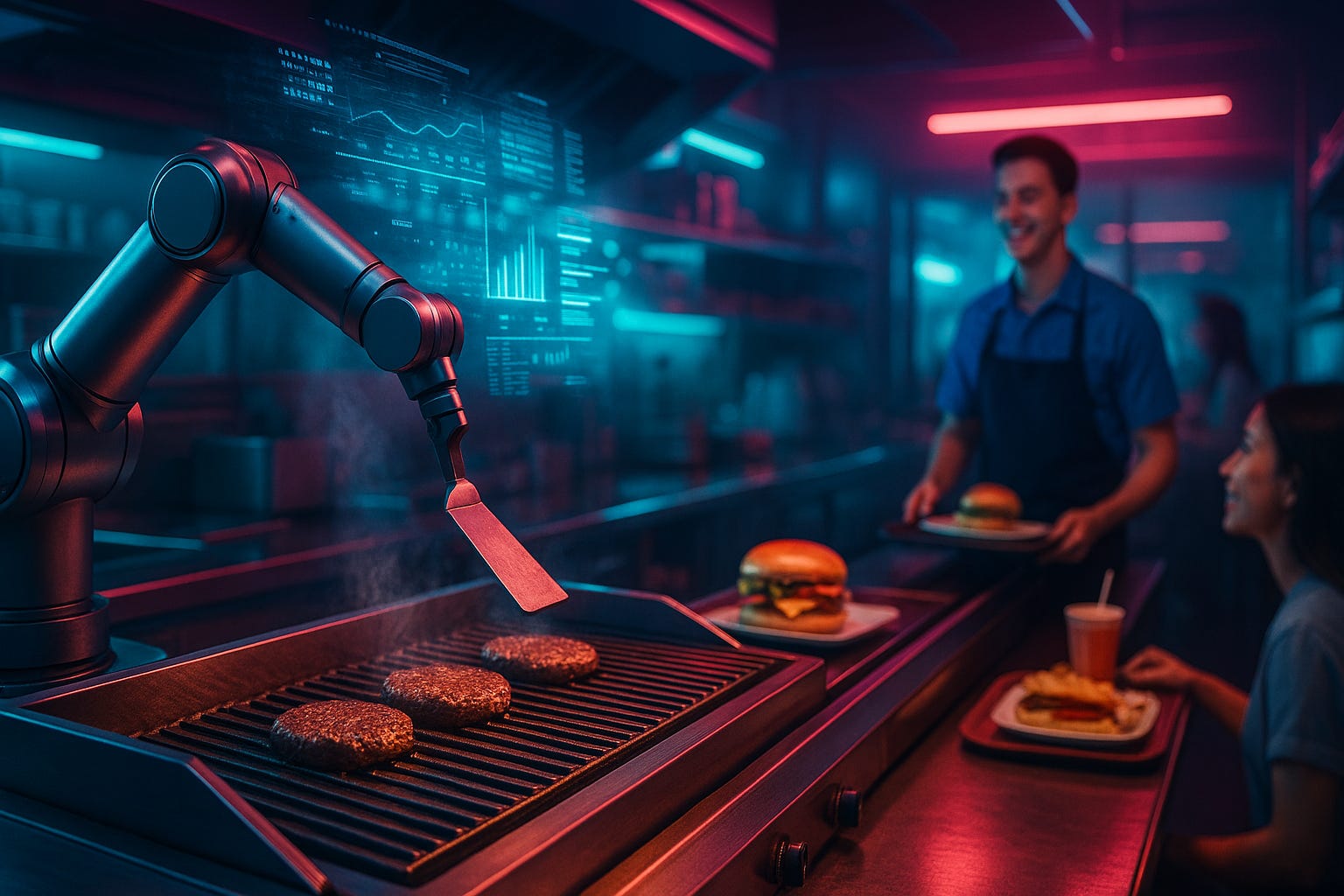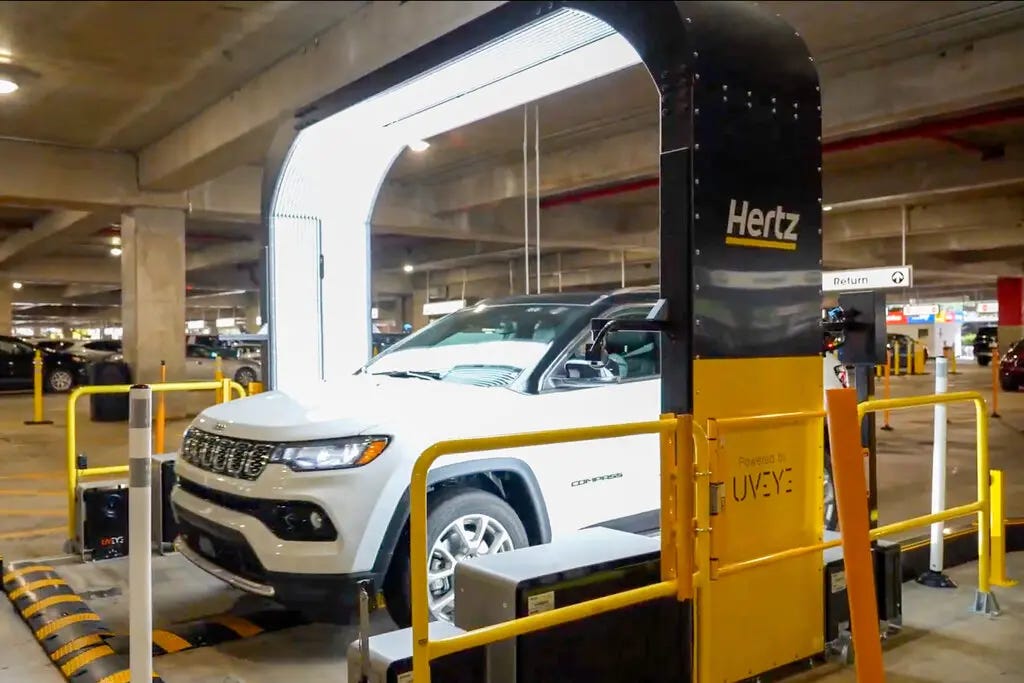machina.mondays // Kitchen Code: How Algorithms Are Changing the Taste of Hospitality
From burger-bots to data-driven menus, AI’s quiet takeover of the back-of-house is reshaping what—and how—we eat.
In this Issue: Generative AI craves real-world input, and Amazon’s new Bee bracelet obliges. It skips wake words, eavesdropping on everything. Convenience beckons, but privacy foots the bill. Bee converts daily chatter into data gold—fuel for your tasks and Amazon’s models. Buying Bee signals that passive listening is a feature, not a flaw. More context grants AI more leverage. Every word becomes searchable history. Handy? Perhaps. Harmless? Unlikely.
You Went Out for Dinner. Now the Algorithm Serves You
From Algorithm to Aroma: The Quiet Revolution of AI Kitchens
The age of algorithmic dining isn’t on the horizon—it’s already flipping burgers, pricing entrées, and transforming hospitality into a data-driven experience that challenges our notions of craft and care.
Taste meets TensorFlow when you step into a quick‑service kitchen at 11:57 a.m., where the choreography looks familiar: grills hiss, timers buzz, and staff hustle before the lunch wave. What diners rarely see is the invisible conductor—a predictive model that has already forecast how many patties and pickles the neighbourhood will crave after the clock strikes twelve. Chains such as Chipotle have paired computer‑vision sensors with AI platforms that signal when more chicken should hit the grill, trimming waste and avoiding stock‑outs in the same move (Appinventiv, 2025).1 Across thousands of locations, shaving a few grams of waste per order converts directly into margin. This is why eight in ten global executives now rank AI investment as their foremost operational priority (Modern Restaurant Management, 2025).2
Robots on the line illustrate how automation is moving from the screen to the hot zone. “Flippy” flips burgers, “Chippy” seasons tortilla chips, and SELF, an autonomous restaurant in Barcelona’s airport, prepares six dishes simultaneously without human hands (DW, 2025).3 The promise is consistency, speed, and all‑day uptime. Hyper‑Robotics reports that a properly maintained burger‑bot can operate twenty‑four hours, producing identical patties while frontline staff redeploy to guest‑facing tasks (Hyper Robotics, 2025).4 Early misfires—like bacon inexplicably landing in McDonald’s sundaes—show the tech is still maturing, yet PYMNTS notes that the same chains doubled their AI budgets even after those public hiccups (PYMNTS, 2025).5 Operations leaders appear convinced that minor glitches cost less than chronic labour shortages and high turnover.
Menus that learn while you eat reveal how generative tools are entering the creative heart of the kitchen. At Woohoo in Dubai every dish begins as a prompt processed by “Chef AI-Man,” a large language model trained on decades of food science (Reuters, 2025).6 Rather than replacing the brigade, Aiman drafts flavour matrices that human cooks test, tweak, and plate. Stateside, independent chefs have started using ChatGPT to brainstorm ingredient pairings that respect seasonality and dietary shifts (Food & Wine, 2025).7 The result is a feedback loop in which guest data, nutritional research, and culinary craft converge, yielding menus that evolve more rapidly than traditional seasonal cycles.
Dynamic pricing and the ethics of appetite come into view when AI decides not only when to marinate chicken but what that chicken should cost. Recommendation engines already highlight high‑margin items on self‑ordering kiosks; the next step is real‑time price adjustment according to demand, weather, or even perceived affluence—a technique some operators quietly test in reservation apps (Food On Demand, 2025).8 The economic logic is sound, yet the optics are fraught. Dynamic pricing can easily slip into dynamic discrimination when algorithms infer a diner’s willingness to pay. Regulators have not yet ruled on the practice, leaving reputational risk for brands that lean too aggressively on invisible mark‑ups. Transparent messaging and opt‑in loyalty tiers may become the minimum safeguard if restaurants hope to wield algorithmic pricing without public backlash.
A future in which diners are greeted by name, served dishes tuned to their macros, and billed transparently will look vastly different from one where kiosks upsell high‑salt snacks to hungry commuters because the algorithm knows they are in a rush.
Data, power, and trust dominate the conversation when we consider that the deeper issue is not whether the code works, but who owns the decision space that code creates. AI platforms require personal data—dietary restrictions, order histories, biometric indicators—to deliver the hyper‑personalisation that marketers celebrate. Each additional data feed broadens the attack surface for cyber threats, prompting McDonald’s and others to flag deepfake and system‑tampering risks in their filings (Modern Restaurant Management, 2025).9 The Spinoff’s investigation into AI‑generated menu photos that bore little resemblance to actual dishes illustrates the reputational hazard when virtual imagery misleads physical reality (The Spinoff, 2024).10 Trust, therefore, becomes a strategic asset. Restaurants that articulate clear data‑use policies and visibly reinforce food authenticity will hold a competitive edge as guests grow more data‑literate.
Human Touch 2.0 emerges when opponents argue that flavour is memory, not mathematics, and that reducing cuisine to acidity curves strips dining of its soul. Yet the dichotomy between machine efficiency and human warmth may be false. When robots run food to tables, servers can linger to explain provenance or accommodate a bespoke spice request. Early pilots show that when repetitive prep is automated, staff satisfaction can rise because employees shift toward storytelling and problem‑solving roles (DW, 2025).11 The skill profile of hospitality work is, in effect, drifting upward. Line cooks become robot whisperers, and managers become data interpreters. The challenge is to invest in up‑skilling so that displaced tasks translate into elevated careers rather than redundancies.
The strategic choice ahead centres on whether the industry will use these capabilities to amplify hospitality or merely to extract surplus value. A future in which diners are greeted by name, served dishes tuned to their macros, and billed transparently will look vastly different from one where kiosks upsell high‑salt snacks to hungry commuters because the algorithm knows they are in a rush. Both futures are technically possible; only one treats data as a covenant rather than a commodity.
Artificial intelligence has passed the novelty phase in food service. What began as a few conveyor‑belt sushi robots now extends from predictive procurement to drone delivery. The next decade will be shaped less by proof‑of‑concept demos and more by governance, labour strategy, and culinary imagination. Restaurants that view AI as an augmentation layer rather than a replacement layer can free people to do what algorithms cannot: sense context, improvise empathy, and turn a meal into a memory. The sector’s most valuable table may prove to be the one where data scientists, chefs, and ethicists sit together, deciding not just how to feed us faster but how to feed us better.
If the algorithm is already plating your dinner, what part of the dining experience do you most want to stay unmistakably human—and why?
PERSPECTIVES
Traders legitimately enjoy trading…I think humans will be calling the shots."
—Vlad Tenev, CEO of Robinhood, “Robinhood CEO: Human traders are safe from AI”, Axios
SPOTLIGHT
Deepfake threats spawn new business for entrepreneurs, investors
Deepfakes have leapt from novelty to serious threat, and investors are racing to back the startups fighting them. Once clunky and easy to spot, AI-generated audio and video are now so convincing that over half of people in a recent study believed they were real. Axios charts the booming market for deepfake detection — from audio and video forensics to watermarking and “narrative attack” defence — where companies like Pindrop and Reality Defender are landing multi-million dollar deals as sightings surge from monthly oddities to daily attacks. (via Axios)
» Don’t miss our SPOTLIGHT analysis—the full breakdown below ⏷
TL;DR TEASER: Deepfakes now fool the eye and drain the budget—our Spotlight shows why forensic detectors can’t keep up and why cryptographic fingerprints may be the only path back to trust. Dive in to see how authenticity is becoming the new competitive edge.
IN-FOCUS
A.I. Is Making Sure You Pay for That Ding on Your Rental Car
Hertz and other rental car companies are rolling out high-tech scanners that use artificial intelligence to spot even the tiniest scratches and dents — and customers are feeling the sting. The system, powered by UVeye, captures thousands of high-resolution images as cars pass through rental gates, automatically flagging discrepancies and triggering damage bills, sometimes for marks renters can barely see. Travelers like Kelly Rogers have been shocked with charges for dents they swear weren’t there, leaving many questioning whether A.I. is catching real damage or just shadows. (via NYT)
» QUICK TAKEAWAY
Major rental car agencies are increasingly hitting customers with hefty fees for even the tiniest blemishes that human inspectors initially missed, leaving renters blindsided by unexpected bills. Multiple travellers have reported surprise charges, such as US$440 for a one‑inch wheel scuff, that bundled repair, processing, and administrative costs, even in cases where Hertz employees confirmed no visible damage when the vehicle was returned.
What You Should Think About When Hiring:
→ Avoid locations known to use these AI scanners if possible, or ask directly before renting.
→ Document vehicle condition thoroughly with your own photos
→ Be cautious of limited customer support and short early‑payment discounts tied to
automatic billing via chatbots or portals.
Google develops AI tool that fills missing words in Roman inscriptions
Historians are calling Google DeepMind’s new A.I. tool, Aeneas, transformative for the study of the ancient world. Trained on nearly 200,000 Latin inscriptions, the system can pinpoint when and where a fragment was created, link it to similar artefacts, and even suggest missing words in damaged texts. Early tests stunned researchers, revealing hidden linguistic connections and helping restore incomplete records like the Res Gestae of Emperor Augustus. Scholars say the technology could revolutionise how we recover and understand the voices of ordinary Romans, once lost to time. (The Guardian)
» READ FULL NATURE PAPER: “Contextualizing ancient texts with generative neural networks”
Inside the Summit Where China Pitched Its AI Agenda to the World
At the World Artificial Intelligence Conference in Shanghai, China launched its Global AI Governance Action Plan, emphasising international cooperation, AI safety, and government oversight of commercial models in sharp contrast to the Trump administration’s deregulation‑focused, America‑first strategy. With the US largely absent—aside from Elon Musk’s xAI—China, Singapore, the UK, and the EU are emerging as the leading coalition for shaping global AI safety standards. Chinese researchers and officials highlighted shared concerns with the US over model bias, hallucinations, and existential risks, while promoting UN‑backed collaboration and open‑source approaches. Although Chinese startups remain more focused on scaling and profit than on existential threats, Beijing’s push for accountability and safety research positions it as a central player in the evolving global AI landscape. (via Wired)
Mark Zuckerberg Details Meta’s Plan for Self-Improving, Superintelligent AI
Mark Zuckerberg announced that Meta’s new Superintelligence Labs will focus on creating self‑improving AI models capable of learning with minimal human input, aiming for “personal superintelligence” to empower individuals rather than centralising automation. He highlighted smartglasses as the ideal interface for these AI systems and revealed that Meta is spending billions—raising capital expenditures to $69 billion—to build frontier models, expand AI infrastructure, and attract top researchers with massive compensation packages. While Meta continues to monetise AI in products like Instagram and WhatsApp, its superintelligence push signals a long‑term bid to compete with OpenAI, Google DeepMind, and Anthropic in the race toward advanced AI that can evolve on its own. (via Wired)
HOT TAKE
Why Amazon Wants an AI Bracelet That Records Everything You Say
Amazon’s latest move into AI wearables is raising eyebrows: the tech giant is acquiring Bee, a $50 voice‑recording bracelet that transcribes everything you say—even private chats and self‑talk—and turns them into searchable logs and automatic to‑do lists. Unlike Alexa, Bee listens constantly without a wake word, giving Amazon a powerful stream of personal data while testing the limits of consumer pr
ivacy and consent. Supporters see it as a glimpse of frictionless AI assistance, while critics call it a dystopian “always‑listening” gadget likely to spark backlash in public spaces and courtrooms alike. (via WSJ)
» OUR HOT TAKE
Amazon’s snap-up of Bee—a $49 wristband that passively records, transcribes and distils your every utterance into reminders and to-do lists—signals the company’s most naked bid yet to extend Alexa-style ambient surveillance from the kitchen counter onto human skin, and it revives the long-dormant “glasshole” dilemma: the moment convenience crosses the line into compulsory performance. The device promises friction-free memory and productivity, yet it also hoovers up the voices of anyone in earshot, effectively deputising users as unwitting data harvesters and forcing bystanders to gamble on Amazon’s notoriously porous privacy promises. Given the backlash that felled Google Glass and the halo of scepticism that surrounds Microsoft’s Recall screen-capture tool, Bee risks becoming the wearable equivalent of a Ring doorbell—normalising ubiquitous recording while outsourcing the moral cost to consumers. Until regulators impose hard consent rules and transparent deletion policies, Bee looks less like a clever next step for personal AI and more like a Silicon Valley thought experiment escaped into the real world—one where the price of perfect recall may be the slow evaporation of informal, unrecorded life.
FINAL THOUGHTS
If your next favourite dish is predicted, priced, and plated by code, is it still comfort food—or comfort data?
___
FEATURED MEDIA
Our fighting humanoid robot boy DeREK completely lost his mind @REKrobot
AI or Real? Can you tell which is which?
A viral video by creator @immadsal has left viewers “breaking their brains” after revealing that most of the seemingly wholesome farm visit, complete with chickens, a dog, and rustic wagons, was almost entirely AI-generated. In the clip, Madeline Salazar walks around a charming farmyard asking viewers to guess which objects and animals are real, only to reveal that the adorable creatures and much of the scenery are convincingly fake. The hyper‑realistic visuals sparked existential reactions online, with users confessing they could no longer trust what they see and warning that AI is advancing faster than our ability to detect it.
Justin Matthews is a creative technologist and senior lecturer at AUT. His work explores futuristic interfaces, holography, AI, and augmented reality, focusing on how emerging tech transforms storytelling. A former digital strategist, he’s produced award-winning screen content and is completing a PhD on speculative interfaces and digital futures.
Nigel Horrocks is a seasoned communications and digital media professional with deep experience in NZ’s internet start-up scene. He’s led major national projects, held senior public affairs roles, edited NZ’s top-selling NetGuide magazine, and lectured in digital media. He recently aced the University of Oxford’s AI Certificate Course.
⚡ From Free to Backed: Why This Matters
This section is usually for paid subscribers — but for now, it’s open. It’s a glimpse of the work we pour real time, care, and a bit of daring into. If it resonates, consider going paid. You’re not just unlocking more — you’re helping it thrive.
___
SPOTLIGHT ANALYSIS
This week’s Spotlight, unpacked—insights and takeaways from our team
Deepfake Detection: Provenance or Perpetual Pursuit?
Generative AI has dragged deepfakes out of the novelty bin and into the heart of everyday risk, where a single synthetic phone call can trigger a wire transfer and a fabricated video can swing an election inside a news cycle. Realism is rising on an exponential curve: the audio glitches and shaky lip‑sync that once gave the game away have vanished, replaced by forgeries so seamless that more than half of casual viewers—and, increasingly, professional investigators—now accept them as genuine. Venture money is pouring into detectors, but every new signature published today becomes fresh training data for attackers tomorrow, locking defenders into a cat‑and‑mouse treadmill of diminishing returns. The debate has therefore pivoted from whether we can spot the fake after the fact to whether we can guarantee authenticity at the moment of creation. Fingerprinting advocates propose cryptographic tags baked into cameras, microphones and editing suites so that any device, browser or inbox can flash an instant red‑or‑green verdict before content spreads, trading perpetual policing for provable provenance.
1. Detection Tools: Fast Deploy, Short Lifespan
Pre‑trained forensic models slide neatly into email gateways, call‑centre queues and social dashboards, scanning legacy archives without asking anyone upstream to change their workflow. In practice they deliver a rolling cease‑fire, not peace: false positives climb as generators close the realism gap, compute bills scale with traffic volume, and every detection signature becomes a lesson for the next wave of forgers.
2. Fingerprinting & Watermarking: Provenance First
Cryptographic stamps baked into cameras, editing suites and publishing pipelines flip the logic from after‑the‑fact policing to upfront proof. When the mark travels with the file, trust checks shrink to a single pass‑fail flash. The catch is uptake. Unless hardware makers, platforms and regulators back the same open standard, provenance fractures into brand silos and the wider web remains an unmarked wild west.
3. Identity Layers & Human Factors
Biometric log‑ins, liveness prompts and narrative‑attack monitors aim to secure the human endpoint, forcing a pause before someone wires funds to a voice that merely sounds like the CEO. They succeed in dampening social‑engineering fallout but at the expense of friction, privacy concerns and a predictable shadow market of workarounds—from photorealistic game avatars spoofing age checks to synthetic “face loans” sold on the dark web.
4. Cost Curve vs. Risk Curve
Financial institutions report the jump from one deepfake incident a month to one per client per day. What began as an insurance premium is now a fixed operating expense spanning detector licences, provenance infrastructure and staff protocols. Boards are no longer asking whether the spend is justified; they are debating how aggressively to extend coverage before the next scandal triggers regulatory penalties.
Strategic Outlook
For the foreseeable future organisations will run a hybrid stack: forensics for everything already in circulation, fingerprinting for new assets, and human escalation paths for whatever still slips through. The competitive edge shifts from catching fakes to proving authenticity in real time. Whoever shapes the provenance standard—whether a consortium of camera makers, a cloud platform, or a regulator—will effectively pick the winners in this market. Authenticity checked at the door beats authenticity disputed in court.
Key Takeaways
Detection is a treadmill: post‑hoc forensics buys time in weeks, not years.
Provenance shifts the game: stamping authenticity at source offers the only structural fix.
Identity checks plug holes: useful, but they trade trust for friction and surveillance concerns.
Budgets are ballooning: deepfakes have moved from hypothetical to operational threat.
Standards will decide winners: early compliance sets the competitive floor.
Appinventiv. (2025). 10 real AI use cases & examples in the restaurant industry. https://appinventiv.com/blog/ai-in-restaurant-industry/
Modern Restaurant Management. (2025). AI has the potential to truly become the brain of the restaurant. https://modernrestaurantmanagement.com/ai-has-the-potential-to-truly-become-the-brain-of-the-restaurant/. Deloitte’s survey of 375 executives shows the money is moving first: 82 percent of restaurant leaders plan to grow their AI budgets this fiscal year, making capital commitment—not curiosity—the clearest signal that AI now sits at the centre of operational strategy.
Deutsche Welle. (2025, June 18). AI in restaurants: When robots serve the food [Video]. https://www.dw.com/en/ai-in-restaurants-efficient-and-sustainable/video-72900338
Hyper Robotics. (2025). Inside the autonomous kitchen: Where AI flips burgers 24/7. https://www.hyper-robotics.com/knowledgebase/inside-the-autonomous-kitchen-where-ai-flips-burgers-24-7/. The CaliExpress “Flippy” case makes the labour math stark: a burger-bot that grills nonstop, never calls in sick, and keeps every patty identical can cut operating costs by up to half while freeing human staff for hospitality roles—turning the kitchen line into the front line of guest experience.
PYMNTS. (2025). Fast‑food chains order up AI despite early missteps. https://www.pymnts.com/news/artificial-intelligence/2025/fast-food-chains-step-up-ai-adoption-despite-early-missteps/
Reuters. (2025, July 10). Dubai to debut restaurant operated by an AI chef. https://www.reuters.com/world/middle-east/dubai-debut-restaurant-operated-by-an-ai-chef-2025-07-10/
Food & Wine. (2025). How restaurants are embracing AI and technology. https://www.foodandwine.com/restaurants-ai-artificial-intelligence-technology-11683792. What jumps off the page isn’t the gadgetry but the mind-shift: marquee independents such as Jean-Georges Vongerichten now pipe ingredient lists and sales data into ChatGPT to surface flavour pairings that track both seasonality and diet trends, treating the model as a sous-chef rather than a novelty.
Food On Demand. (2025, July 8). You heard right, AI in restaurants is becoming normal. https://foodondemand.com/07082025/you-heard-right-ai-in-restaurants-is-rapidly-accelerating/
Modern Restaurant Management. (2025). AI has the potential to truly become the brain of the restaurant. The cybersecurity warning is blunt: as restaurants bolt on more data streams, their “digital brain” grows—but so does the attack surface. Even McDonald’s has begun flagging deep-fake orders and system-tampering threats in regulatory filings, underscoring that AI ambitions will stall unless security scales in lockstep with data appetite.
The Spinoff. (2024, September 21). Beware the online menus with AI food photos. https://thespinoff.co.nz/society/21-09-2024/beware-the-online-menus-with-ai-food-photos
Deutsche Welle. (2025, June 18). AI in restaurants: When robots serve the food [Video]









What if I only ate meals chosen by algorithm for three days straight? Calories hit, cravings dampened—but did I feel fed, or just managed?
The Bee bracelet doesn’t just listen. It teaches silence to be suspicious.